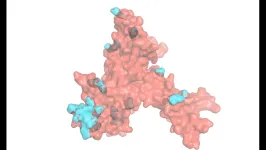(Press-News.org) SAN FRANCISCO, CA—March 7, 2023—Compared to those of us who live at sea level, the 2 million people worldwide who live above 4,500 meters (or 14,764 feet) of elevation—about the height of Mount Rainier, Mount Whitney, and many Colorado and Alaska peaks—have lower rates of metabolic diseases such as diabetes, coronary artery disease, hypercholesterolemia, and obesity.
Now, researchers at Gladstone Institutes have shed light on this phenomenon. They showed how chronically low oxygen levels, such as those experienced at high elevation, rewire how mice burn sugars and fats. The work, published in the journal Cell Metabolism, not only helps explain the metabolic differences of people who live at high altitude, but could also lead to new treatments for metabolic disease.
“When an organism is exposed to chronically low levels of oxygen, we found that different organs reshuffle their fuel sources and their energy-producing pathways in various ways,” says Gladstone Assistant Investigator Isha Jain, PhD, senior author of the new study. “We hope these findings will help us identify metabolic switches that might be beneficial for metabolism even outside of low-oxygen environments.”
Mimicking High Altitude Living
Around sea level, where a third of the world’s population lives, oxygen makes up about 21 percent of the air we breathe. But people who live above 4,500 meters, where oxygen makes up just 11 percent of the air, can adapt to the shortage of oxygen—known as hypoxia—and thrive.
Researchers studying the impact of hypoxia have typically carried out their research in isolated cells or within cancerous tumors, which often lack oxygen. Jain’s group wanted a more nuanced look at how long-term hypoxia impacts organs throughout the body.
“We wanted to profile the metabolic changes that take place as an organism adapts to hypoxia,” says Ayush Midha, a graduate student in Jain’s lab and first author of the new paper. “We thought this might provide some insight into how that adaptation protects against metabolic disease.”
Midha, Jain, and their colleagues at Gladstone and UC San Francisco (UCSF) housed adult mice in pressure chambers containing either 21 percent, 11 percent, or 8 percent oxygen—all levels at which both humans and mice can survive. Over 3 weeks, they observed the animals’ behavior, monitored their temperature, carbon dioxide levels and blood glucose, and used positron emission tomography (PET) scans to study how different organs were consuming nutrients.
Redistributing Fuel
In the first days of hypoxia, the mice living in 11 percent or 8 percent oxygen moved less, spending hours completely still. By the end of the third week, however, their movement patterns had returned to normal. Similarly, carbon dioxide levels in the blood—which decrease when mice or humans breathe faster to try to get more oxygen—initially decreased but returned to normal levels by the end of the 3 weeks.
The animals’ metabolism, however, seemed more permanently altered by the hypoxia. For animals housed within the hypoxic cages, blood glucose levels and body weight both dropped, and neither returned to pre-hypoxic levels. In general, these more lasting changes mirror what has been seen in humans who live at high altitude.
When the researchers analyzed PET scans of each organ, they also discovered lasting changes. To metabolize fatty acids (the building blocks of fats) and amino acids (the building blocks of proteins), the body needs high levels of oxygen, while less oxygen is required to metabolize the sugar glucose. In most organs, hypoxia led to an increase in glucose metabolism—an expected response to the shortage of oxygen. But the scientists found that in brown fat and skeletal muscle—two organs already known for their high levels of glucose metabolism—levels of glucose consumption instead went down.
“Prior to this study, the assumption in the field was that in hypoxic conditions, your whole body’s metabolism becomes more efficient in using oxygen, which means it burns more glucose and fewer fatty acids and amino acids,” says Jain, who is also an assistant professor in the Department of Biochemistry at UCSF. “We showed that while some organs are indeed consuming more glucose, others become glucose savers instead.”
In retrospect, Jain says the observation makes sense; the isolated cells previously studied don’t need to make trade-offs to save glucose, while an entire animal, to survive, does.
The lasting effects of long-term hypoxia seen in the mice— lower body weight and glucose levels—are both associated with a lower risk of diseases in humans, including cardiovascular disease. Understanding how hypoxia contributes to these changes could lead to new drugs that mimic these beneficial effects.
With that goal in mind, Jain’s group hopes to follow up on this work with studies that look even more closely at how individual cell types and levels of signaling molecules change in different ways with hypoxia. Such research could point toward ways to mimic the protective metabolic effects of hypoxia with drugs—or high-altitude trips.
“We already see athletes going to train at altitude to improve their athletic performance; maybe in the future, we’ll start recommending that people spend time at high altitude for other health reasons,” says Midha.
###
About the Study
The paper “Organ-Specific Fuel Rewiring in Acute and Chronic Hypoxia Redistributes Glucose and Fatty Acid Metabolism” was published in the journal Cell Metabolism on March 7, 2023.
Other authors are Yuyin Zhou, Bruno Queliconi, Alex Barrios, Augustinus Haribowo, and Brandon Chew of Gladstone; and Cyril Fong, Joseph Blecha, Henry VanBrocklin, and Younghou Seo of UCSF.
The work was supported by the Medical Scientist Training Program of the National Institute of General Medical Sciences (T32GM141323), the National Institutes of Health (DP5OD026398), Defense Advanced Research Projects Agency (HR0011- 474 19-2-0018), the California Institute for Regenerative Medicine, and the National Science Foundation (2034836).
About Gladstone Institutes
Gladstone Institutes is an independent, nonprofit life science research organization that uses visionary science and technology to overcome disease. Established in 1979, it is located in the epicenter of biomedical and technological innovation, in the Mission Bay neighborhood of San Francisco. Gladstone has created a research model that disrupts how science is done, funds big ideas, and attracts the brightest minds.
END
Endocrine Society members elected John Newell-Price, M.D., Ph.D., F.R.C.P., as its 2024-2025 President. He will serve as President-Elect for a year beginning in June 2023 before becoming President in June 2024.
Newell-Price is Professor of Endocrinology at the University of Sheffield in Sheffield, United Kingdom. He also is head of the endocrinology service at the Sheffield Teaching Hospitals NHS Foundation Trust and of the European Neuroendocrine Tumor Society at the hospital.
Newell-Price’s clinical expertise ...
BOSTON – New research led by investigators at Massachusetts General Hospital (MGH), a founding member of Mass General Brigham (MGB), indicates that socioeconomic and genetic factors likely interact in an additive way to affect people’s risks of developing obesity and type 2 diabetes. The findings, which are published in Diabetes Care, suggest that interventions to improve socioeconomic deprivation may decrease metabolic diseases at the individual and community levels, especially among people with concomitant high genetic risk.
Genetic and socioeconomic factors—one intrinsic and unmodifiable and ...
Note: Johns Hopkins Medicine researchers Deok-Ho Kim and Devin Mair will participate in a NASA teleconference for journalists on Tuesday, March 14, at 11 a.m. ET.
Johns Hopkins Medicine researchers are collaborating with NASA to send human heart “tissue-on-a-chip” specimens into space as early as March. The project is designed to monitor the tissue for changes in heart muscle cells’ mitochondria (their power supply) and ability to contract in low-gravity conditions.
The tissue samples will ...
Researchers at the Centre for Genomic Regulation (CRG) in Barcelona have discovered a mechanism involving ribosomes which helps the heart toggle between a ‘regular maintenance mode’ for day-to-day function and an ‘energy-boost mode’ which aids recovery for high-demand situations including heart attacks. The findings are published in a ‘Breakthrough Article’ in the journal Nucleic Acids Research, a distinction awarded to studies that answer long-standing questions in the field.
Ribosomes are the molecular factories that manufacture proteins in all living cells. Historically, they have been ...
Experts from NYU Langone Orthopedics will present their latest clinical findings and research discoveries at the 2023 American Academy of Orthopaedic Surgeons (AAOS) Annual Meeting, March 7 to 11, in Las Vegas.
Topics being presented include the following:
minimally invasive in-office needle arthroscopy to diagnosis and treat a common cause of chronic ankle pain
improving postoperative pain with intraoperative injections during hip fracture surgery
using an additional dose of dexamethasone to reduce postoperative opioid use for pain after knee replacement
“Our clinical teams continue to innovate and investigate how we can provide our patients with the best possible outcomes. ...
A new RAND Corporation report finds that the basic infrastructure to support elementary (grades K-5) social studies instruction – academic standards, accountability requirements, assessment programs – is inadequate in many states. Even where state-level infrastructure to guide teachers’ instruction is in place, its comprehensiveness and quality vary greatly.
Support and guidance at the district and school level to underpin social studies instruction are also lacking compared to other core academic ...
Scientists at Lawrence Berkeley National Laboratory (Berkeley Lab) have developed a conductive polymer coating – called HOS-PFM – that could enable longer lasting, more powerful lithium-ion batteries for electric vehicles.
“The advance opens up a new approach to developing EV batteries that are more affordable and easy to manufacture,“ said Gao Liu, a senior scientist in Berkeley Lab’s Energy Technologies Area.
The HOS-PFM coating conducts both electrons and ions at the same time. This ensures battery stability and high charge/discharge rates while enhancing battery life. The coating ...
A research team, affiliated with UNIST has unveiled a key factor involved in the DNA damage response (DDR), homologous recombination (HR) and DNA interstrand crosslink (ICL) repair. According to the research team, their findings are expected to establish an effective control environment for chromosome instability (CIN), a major factor in cancer evolution, and further help combat malignant tumors .
Published in the January 2023 issue of Nucleic Acids Research, this breakthrough ...
BIRMINGHAM, Ala. – A United States Food and Drug Administration mandate to limit the dosage of acetaminophen in pills that combine acetaminophen and opioid medications is significantly associated with subsequent reductions in serious liver injury, researchers report in the medical journal JAMA. The federal mandate was announced in 2011 and implemented in 2014.
“The FDA mandate that limits acetaminophen dosage to 325 milligrams per tablet in combination acetaminophen-opioid medications was associated with a significant and persistent decline in the yearly rate of hospitalizations and proportion per year of acute liver failure ...
WASHINGTON, March 7, 2023 – Proxy data – indirect records of the Earth’s climate found in unlikely places like coral, pollen, trees, and sediments – show interesting oscillations approximately every 100,000 years starting about 1 million years ago. Strong changes in global ice volume, sea level, carbon dioxide concentration, and surface temperature indicate cycles of a long, slow transition to a glacial period and an abrupt switch to a warm and short interglacial period.
Milutin Milankovitch hypothesized that the timing of these cycles was controlled by the orbital parameters of the Earth, including the shape of its path around ...






